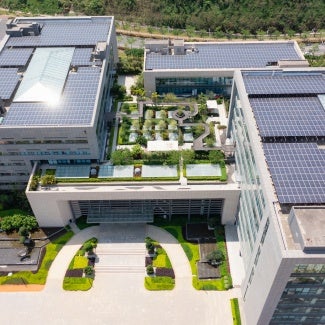The role of specifications in sustainable design
Author: Deltek
Research from AIA uncovers the perspectives of architects on working with manufacturers, clients, and contractors to specify sustainably. AIA partner Deltek dives into the results.

Sustainable design specification
Architects are at the center of incorporating sustainability into design projects, particularly when it comes to selecting sustainable building products and materials. Whether client-driven or architect-driven, the burden of responsibility for ensuring sustainable practices are incorporated into drawings and documents, while remaining resistant to value engineering, largely rests on the design team and specifiers.
What challenges do architects face when designing and specifying to certain sustainable standards? How do architects define “sustainable” and evaluate whether a product meets this definition? What roadblocks do they face when working with manufacturers, contractors and owners?
Deltek recently sponsored new AIA research that examines some of these questions and sheds light on how building project stakeholders can collaborate more effectively on green building initiatives. The research report, Sustainability in the Architect’s Journey to Specification 2020, shows that a majority of architects with specification responsibilities want to specify more sustainably in the future and see it as an opportunity for growth. This is explored in two key areas: Attitudes and responsibilities of project stakeholders and sustainable information and certifications.
The role of project stakeholders
The role of an architect in setting the course for sustainable design is complex. According to the new research, architects feel responsible for promoting sustainability and green building practices, but don’t necessarily feel empowered to implement those practices.
For example:
- 60% of architects consider sustainability at least half the time during product specification.
- 79% of architects (97% among Millennials) want to specify more sustainable products and materials than they do today.
However:
- Just 1 in 3 architects feel they are adequately meeting their responsibility to design sustainably.
- According to architects, 70% of owner-clients are too cost-focused when it comes to selecting sustainable material, and only 22% of clients are willing to pay more for sustainable solutions.
- 59% of architects feel a lack of support from colleagues and project stakeholders (internal project teams, contractors, etc.).
How can firms and project teams come together to ensure that sustainable design goals and outcomes are realized and do not get lost due to lack of buy-in, incorrect perceptions about cost, or value engineering? According to the Environmental and Energy Study Institute (EESI), residential and commercial buildings account for 40% of energy-related carbon emissions. Architects need the support of firm leaders to champion sustainability and work closely with clients to educate and shift the narrative. With 97% of Millennials reporting their desire to specify more sustainable materials, supporting this need is essential for recruiting and retaining talent.
Gathering & evaluating sustainable information
While not every building project will seek a sustainable certification such as LEED or WELL, product and material selection plays an important role in considering the overall carbon footprint of a project. This is where the architect and manufacturer relationship becomes critical.
According to the research, 81% of architects consider the sustainability of a product related to its use and installation, and 64% of architects consider sustainability most during the specification phase of a project. Manufacturer websites are the most-used form of product sustainability research (82%); however, continuing education (CE) courses are considered the most impactful (67%).
Manufacturers should be equipped to educate designers and product specifiers about the broader scope of a sustainable product. This includes how the product or material was sourced and manufactured, the supply chain and shipping implications, and, finally, the shelf life of the product and options for recycling or safe disposal.
Architects and manufacturers who work together to consider the circular economy of product selection will be better prepared to inform and enable clients and contractors to implement the materials and installation requirements. Clear product specifications that consider these end-to-end sustainable implications will naturally be more resistant to value engineering.
Next steps for sustainable design
Although there is no magic formula for tackling mindset and project barriers to sustainable design, there is an abundance of key trends and benchmarks in Sustainability in the Architect’s Journey to Specification 2020 that can help lead the way.
Small steps in leadership, stakeholder relationships, and sourcing of product information can make a sizable impact on the future of sustainable projects.
Deltek empowers your firm to deliver the speed of design and the breadth of services that your clients demand. Our project-based solutions can be seamlessly and securely delivered on-premises or via the Cloud and can help A&E firms manage the complete project lifecycle, including business development, specification management, project management, talent management, document management, and financial management. Whether you’re a small growing firm or a larger sophisticated organization, Deltek has the right solution for you. Visit deltek.com/aeresources to learn more.



